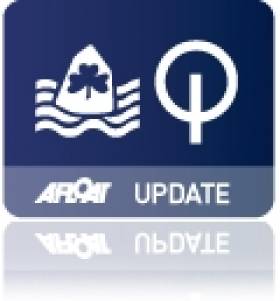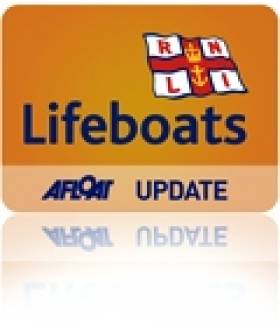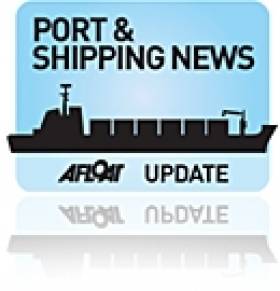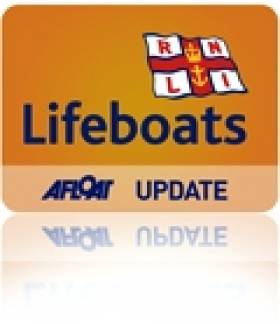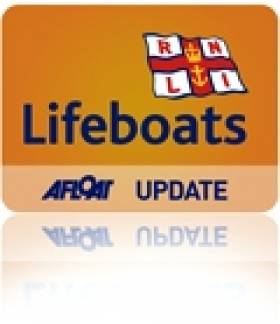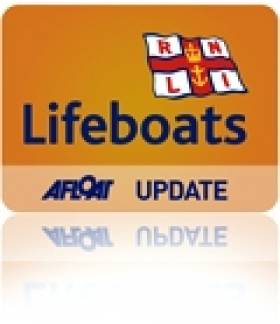Displaying items by tag: Baltimore
#MarineWildlife - A tip of the hat to @BestBaltimore on Twitter for this video of a dolphin 'superpod' that congregated outside Baltimore Harbour in West Cork yesterday (Thursday 15 May).
Such superpods can comprise as many as 1,000 or more dolphins - so the vast numbers seen here breaching the surface may only have been a fraction of a much larger group.
Early last year researchers captured video of a superpod hundreds of dolphins strong in the Irish Sea, with one describing the scene as "boiling" with the gregarious marine mammals.
#optimist – A top Irish youth sailor has opted out of his place on the European Optimist team in favour of a place on the startline at the world championships in October.
Irish champion sailor Harry Durcan (14) from Royal Cork and Baltimore Sailing Club who came third at the trials this year has made the tough choice to go to the worlds on his own as the IODAI are not sending a team this year.
Harry has opted to go to the Worlds instead of the Europeans as you cannot attend both under Irish Optimist Dinghy Association (IODAI) rulings.
Normally the top five finishers at trials go to the Worlds but this year IODAI are not supporting a team because it's been held during school term.
The World Championships this year are on in San Isidro, Buenos Aires, Argentina in October. Durcan's preparations will be to train with the Irish 2014 Optimist European Team from now until the European event in Dun Laoghaire in order to help them and himself. He will also attend all the Irish regional events. He then plans to train with the Danish Team and their coach Dennis Passke for the week before the Europeans in Dun Laoghaire. He will then travel to Weymouth for the British Nationals at the 2012 Olympic Games venue and from there to Germany for the German nationals in August.

Harry picks up a top Optimist prize in Italy
He goes as the only Irish sailor to Argentina but has completed two world championships before, in Lake Garda in 2013 and the Dominican Republic in 2012.
Durcan also competed an event in Riva Del Garda at Easter and placed 9th out of 800 sailors, the best ever result for an Irish sailor at such an event. In March he was in Oman for an event with some of the top sailors from Europe. 'I am now looking forward to a fun Summer ahead and getting some training and racing under my belt' he told Afloat.ie
Baltimore Lifeboat Rescues Grounded Yacht From West Cork Rocks
#lifeboat – On a sunny Easter Sunday Morning, 20th April 2014, both the all weather lifeboat and inshore lifeboat were called upon to give assistance. A yacht had grounded on rocks at a treacherous stretch between Cunnamore Pier and Heir Island in West Cork on a falling tide. The 35ft yacht had 4 people on board at the time. The yacht was well aground when the lifeboats arrived.
The inshore lifeboat RIB crew went aboard the stricken vessel first. A line was secured to the yacht's stern and another line to the masthead. Helm Tadhg Collins on the inshore lifeboat RIB pulled on the masthead line, heeling the yacht over to reduce her draught. Then Coxswain Aidan Bushe on the allweather lifeboat towed the yacht astern to release her from the rocks on which she was wedged.The lifeboat established a tow to bring the yacht to safety. There were no injuries. Winds were fresh North North Easterly.
On the allweather lifeboat Coxswain Aidan Bushe, Mechanic Cathal Cottrell, Eoin Ryan, Ronnie Carthy, Brian MacSweeny, Sean McCarthy, Jerry Smith
On the inshore lifeboat Helm:Tadhg Collins, John Kearney, Jason Pavry
#Shipping - A cargo ship captain has been fined by Cork District Cork over failing to immediately inform the Irish Coast Guard of engine difficulties suffered by his vessel late last month.
As the Irish Examiner reports, the Department of Transport, Tourism and Sport brought the case against Turkish national Mehmet Kaya, captain of the 140m Begonia G that was travelling from Foynes to the Port of Cork with its fertiliser cargo on the evening of 27 February when it lost engine power in poor weather some eight miles off Baltimore.
The court hard that the vessel began to drift towards shore, but Valentia Coast Guard was only made aware of the incident independently some two hours after it began.
Kaya's solicitor entered a guilty plea on the charge of breaching a vessel traffic directive in not informing the coastguard of his ship's loss of manoeuvrability.
The Irish Examiner has more on the story HERE.
Despite Storm Damage 'Happy Baltimore' Village Turns Out to Dance
#dancingRNLI – Despite its battering at the hands of the winter storms Baltimore's maritime community made the best of things by producing an upbeat video to show how resilient the little village is.Filmed on 16th February 2014 hours after storms had ravaged West Cork - this coastal community turned out to dance. Look out for a cast of familiar faces, including a dancing RNLI Lifeboat crew.
Baltimore Lifeboat Assists Three On Trawler Off Cape Clear
#RNLI - Baltimore RNLI assisted three crew members on board a 20m fishing trawler which got into difficulty off West Cork on Monday night (20 January).
The volunteer lifeboat crew was requested to launch their all-weather lifeboat by the Irish Coast Guard at 11.10pm following a report that a 20m trawler had lost steering three quarters of a mile south west of Cape Clear.
The lifeboat, under coxswain Aidan Bushe, launched at 11.18pm and made its way to the scene. Weather conditions at the time were described as blowing force four to five south westerly winds and there was a three metre swell.
Having established a tow line, the lifeboat brought the vessel safely back to Baltimore.
Speaking following the call out, Baltimore RNLI lifeboat operations manager Tom Bushe said: "The vessel encountered difficulties late last night when it was dark and the weather conditions were fairly challenging.
"We were delighted to be able to assist and help the crew bring their vessel to safety."
Baltimore Lifeboat In Medical Evacuation From Skerkin Island
#RNLI - While most of the country was taking refuge from storm-force winds today (6 January), the volunteer lifeboat crew from Baltimore RNLI was called upon to assist in a medical evacuation from Sherkin Island in West Cork.
The call for assistance came at 12.23pm today when an elderly man suffered a badly broken leg.
The all-weather lifeboat, which is designed for severe weather conditions, safely made its way across Baltimore Harbour to the island, but considerable seamanship skills were required in the transfer of the stretchered casualty as a consequence of the large draw at Sherkin Pier.
Prior to transfer, the man had received medical attention and was strapped to a stretcher immobilising the injured leg.
Baltimore RNLI coxswain Kieran Cotter brought the injured man ashore at the new RNLI station at Bull Point in Baltimore. The man was transferred to an ambulance for further medical attention.
Volunteers onboard the lifeboat with Cotter were mechanic Cathal Cottrell and crew members Aidan Bushe, Jerry Smith, Micheal Cottrell, Pat Collins and Tadgh Collins. Shore crew included Tom Kelly, Ronnie Carthy, Diarmuid Colins and Colin Whooley.
Baltimore Lifeboat Rescue to Feature in RNLI's World War One exhibition
#rnli – The role of Baltimore in the rescue of 23 people from a steamship called Alondra which was wrecked off the West Cork village in late 1916, is to be featured in an RNLI touring exhibition commemorating the centenary of World War One (WW1). The charity's exhibition, funded by Arts Council England, is called Hope in the Great War and will honour the courage and bravery of the lifeboat crew who risked their lives to save others during WW1.
While a lot of people will be familiar with the sinking of the Lusitania off the Cork coast in 1915, not as many will be aware of this rescue which took place in Baltimore a year later.
A decision by the RNLI charity to establish a lifeboat station at Baltimore was made in 1913 but its actual opening took place in 1919, having been delayed by the First World War.
It was on the 29 December 1916 that the SSAlondra was wrecked on the Kedge Rock, off Baltimore. Sixteen of her crew left in one of the ship's boats, but drowned before reaching the shore. The Venerable Archeacon John Richard Hedge Becher (Honorary Secretary of Baltimore RNLI) and some volunteers launched a boat but it failed to reach the vessel. They returned to Baltimore but put off again as some of the ship's crew had made the rock. Failing to reach the wreck they put back to shore again. At daylight they set out with rocket apparatus. About the same time, two Royal Navy trawlers came upon the scene and the efforts of all, saved 23 survivors some of whom were lowered down a 150 foot cliff.
RNLI Silver Medals for Gallantry were awarded to Archdeacon Becher and Lieutenant Sanderson for their role in helping to rescue the 23 men fromAlondra.
Baltimore's lifesaving story has been chosen to feature alongside five other RNLI lifeboat services that took place in communities across Ireland and the UK. Opening in February 2014 at the Henry Blogg Museum in Norfolk, Hope in the Great Warwill start a four year tour around RNLI museums, lifeboat stations and other museums.
Now the RNLI is asking the local community in Baltimore to get in contact if they know of any details such as family memories, photographs, letters or artefacts connected to the rescue. The most relevant items may be selected to feature within the exhibition allowing the fullest story of the rescue to be told nationally.
Becky Fletcher, RNLI Heritage Project Co-ordinator said: 'The outstanding efforts by Baltimore's RNLI volunteers to save lives in WW1 will now be given a voice. Although little details are known about the SSAlondra rescue, finding any connections would undoubtedly be of further inspiration.'
To pass on any family memories, anecdotes, photos or letters, please [email protected] or call the RNLI Henry Blogg Museum on 01263 511294.
Locally meanwhile, Baltimore RNLI is teaming up with members of the Baltimore Amateur Drama Group to create a piece of artwork for the tour. The group is creating a short film about the rescue which will feature within the exhibition.
Olan Marten, spokesperson for the drama group explains: 'With so many members of the RNLI supporting our productions over the years, as either cast members, crew or audience it is a great honour to do something for them and also to honour the brave men involved in the Alondra rescue. It's an unusual production as the crew and the director will meet for the first time on the first day of filming. Not only that but the film will travel all over Ireland and the UK for four years introducing these local amateur actors to a huge audience.'
Baltimore RNLI will be the second Cork lifeboat station to mark the role it played during World War One. The Courtmacsherry RNLI Lusitania Centenary Committee has already appealed to the public for artefacts, stories and memorabilia to be part of a major exhibition to commemorate the centenary of the sinking of the Lusitania off the Cork coast in 1915. They are also calling on any family members of those lost or saved in the Lusitania tragedy to contact them to share their stories, which will then be compiled and included in the exhibition.
The commemoration will be held on the May Bank holiday weekend 2015 with the centrepiece being a Lusitania Exhibition in Courtmacsherry RNLI Lifeboat Station and other local venues. Courtmacsherry lifeboat responded to the tragedy in 1915 and to coincide with the exhibition, the lifeboat crew will re-enact the call to service and row out to the site of the disaster.
Baltimore Lifeboat Rescue To Feature In RNLI Great War Exhibition
#RNLI - The role of Baltimore in the rescue of 23 people from the steamship Alondra, wrecked off the West Cork village in late 1916, is to be featured in a touring RNLI exhibition commemorating the centenary of the First World War.
Hope in the Great War, funded by Arts Council England, will honour the courage and bravery of the lifeboat crew who risked their lives to save others during WWI.
While many will be familiar with the sinking of the Lusitania off the Cork coast in 1915, fewer will be aware of this rescue, which took place in Baltimore a year later.
A decision by the RNLI charity to establish a lifeboat station at Baltimore was made in 1913 but its actual opening took place in 1919, having been delayed by the war.
It was on the 29 December 1916 that the SS Alondra was wrecked on the Kedge Rock, off Baltimore. Sixteen of her crew left in one of the ship’s boats, but drowned before reaching the shore.
The Venerable Archeacon John Richard Hedge Becher - honorary secretary of Baltimore RNLI - and some volunteers launched a boat but it failed to reach the vessel. They returned to Baltimore but put off again as some of the ship’s crew had made the rock. Failing to reach the wreck, they put back to shore again.
At daylight they set out with rocket apparatus. About the same time, two Royal Navy trawlers came upon the scene and the efforts of all, saved 23 survivors some of whom were lowered down a 150-foot cliff.
RNLI Silver Medals for Gallantry were awarded to Archdeacon Becher and Lieutenant Sanderson for their role in helping to rescue the 23 men from Alondra.
Baltimore’s lifesaving story has been chosen to feature alongside five other RNLI lifeboat services that took place in communities across Ireland and the UK.
Opening in February 2014 at the Henry Blogg Museum in Norfolk, Hope in the Great War will start a four-year tour around RNLI museums, lifeboat stations and other museums.
Now the RNLI is asking the local community in Baltimore to get in contact if they know of any details such as family memories, photographs, letters or artefacts connected to the rescue. The most relevant items may be selected to feature within the exhibition allowing the fullest story of the rescue to be told nationally.
RNLI heritage project co-ordinator Becky Fletcher said: “The outstanding efforts by Baltimore’s RNLI volunteers to save lives in WW1 will now be given a voice. “Although little details are known about the SS Alondra rescue, finding any connections would undoubtedly be of further inspiration.”
To pass on any family memories, anecdotes, photos or letters, please email [email protected] or call the RNLI Henry Blogg Museum on 01263 511294.
Locally, meanwhile, Baltimore RNLI is teaming up with members of the Baltimore Amateur Drama Group to create a piece of artwork for the tour. The group is creating a short film about the rescue which will feature within the exhibition.
Olan Marten, spokesperson for the drama group, said: “With so many members of the RNLI supporting our productions over the years, as either cast members, crew or audience it is a great honour to do something for them and also to honour the brave men involved in the Alondra rescue.
“It’s an unusual production as the crew and the director will meet for the first time on the first day of filming. Not only that but the film will travel all over Ireland and the UK for four years introducing these local amateur actors to a huge audience.”
Baltimore RNLI will be the second Cork lifeboat station to mark the role it played during the First World War.
The Courtmacsherry RNLI Lusitania Centenary Committee has already appealed to the public for artefacts, stories and memorabilia to be part of a major exhibition to commemorate the centenary of the sinking of the Lusitania off the Cork coast in 1915.
They are also calling on any family members of those lost or saved in the Lusitania tragedy to contact them to share their stories, which will then be compiled and included in the exhibition.
The commemoration will be held on the May Bank holiday weekend in 2015, with the centrepiece being a Lusitania Exhibition in Courtmacsherry RNLI Lifeboat Station and other local venues.
Courtmacsherry lifeboat responded to the tragedy in 1915 - and to coincide with the exhibition, the lifeboat crew will re-enact the call to service and row out to the site of the disaster.
Open Day At Baltimore Lifeboat Station This Weekend
#RNLI - The crew of Baltimore Lifeboat Station are inviting the public to an open day on Sunday 29 September from 2.30pm to 5.30pm.
Visitors on the day will have an opportunity to see the redeveloped station house at Bullpoint and the co-located lifeboats operating from there.
The inshore lifeboat Atlantic 75 RIB Alice and Charles is housed inside the station house on a carriage and the Tamar class all-weather lifeboat Alan Massey lies alongside in a newly excavated berth.
Crew will be on hand to show people around the station house and the lifeboats as well as giving a first hand account of rescues at sea. Information on RNLI Sea Safety resources will also be made available.
All are welcome to the open day, which is free of charge.



























